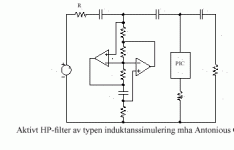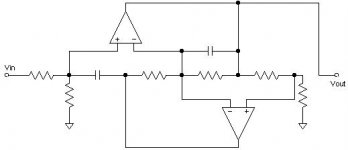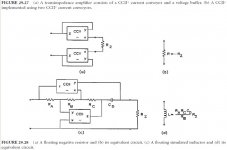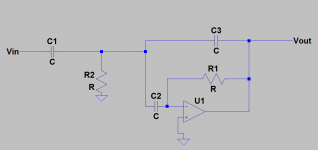Re: Re: FDNR in active filters
Hi,
Complete DAC project with PCM63 and FDNR was published in Elektor 10/92 (German version).
Regards
GaryB said:Take a look at the PCM63 datasheet: http://focus.ti.com/lit/ds/symlink/pcm63.pdf
Hi,
Complete DAC project with PCM63 and FDNR was published in Elektor 10/92 (German version).
Regards
Peranders wants to build a HIGHpass, so the DAC project wouldn't help him much.
You have to use an inductor to ground in order to get a highpass filter (wheter it is first-order with a series resistor or 2nd order with a series cap). This can be simulated using a gyrator or the well-known simulated inductor as it is used in many EQ circuits.
Both of these are grounded however. But I don't see any reason to use sophisticated circuitry that can be run ungrounded, only to substitute a simple cap.
Regards
Charles
You have to use an inductor to ground in order to get a highpass filter (wheter it is first-order with a series resistor or 2nd order with a series cap). This can be simulated using a gyrator or the well-known simulated inductor as it is used in many EQ circuits.
Both of these are grounded however. But I don't see any reason to use sophisticated circuitry that can be run ungrounded, only to substitute a simple cap.
Regards
Charles
Since overkill is my brand I thought it would be cool to design a well-made ultra universal filter but this is a rather big project so I'll guess I can't make it this week. Seriously, I have thought about it 10 years now and time to time it pops up in my brain.peranders said:I have small plans to make a really cool cross over filter. I had in mind, 2nd, 3rd and 4th order LP sub, LP, BP and HP filter. Super universal with universal charateristics, Chebushev, Butterworth, Bessel (anykind) etc.
It seems that FDNR is a totally unexplored field. Maybe we should explore it for hifi usage?
The opamps I think of here are AD8620 and OPA2134. The opamps have to be dual (=matched), so have I been told.
peranders said:Please, guys, my questionnow was about high-pass filters and you don't have them in CD players.
Don't be nervous....
Search for "GIC" in browser...You will find something like this......
Attachments
A possible solution is to use GIC as an inductor but the goal was (if it's possible) to have an all-FDNR filter.phase_accurate said:But I don't see any reason to use sophisticated circuitry that can be run ungrounded, only to substitute a simple cap.
I think I'll get the picture now, using SPICE. The last element is a resistor which will be conveted into a capacitor. It's OK to have a cap as load up to a finite frequency. Highpass fillter has a cap to "unlimited frequency => unrealistic current demands.
I'll guess that it's true that highpass filters can't be made by FDNR. In theory it will but not in real life.
I'll guess that it's true that highpass filters can't be made by FDNR. In theory it will but not in real life.
peranders said:
I'll guess that it's true that highpass filters can't be made by FDNR. In theory it will but not in real life.
Here's a floating Current Conveyor, from
http://www.kemt.fei.tuke.sk/Predmety/KEMT350_EP/_materialy/ch029.pdf
it's in part 29.3 of the article:
Attachments
I started investigating FDNR's again.
I used a 1 op-amp grounded FDNR on my crossover page, and also a 1 op-amp grounded gyrator (inductor simulator).
One-end-is-grounded one-opamp FDNR's and gyrators use 1 opamp instead of 2, which is very useful for shunt legs on filters; its downside is it has a parasitic shunt R (in the case of the FDNR, series R in the case of the gyrator), which, with careful design, can be rendered insignificant.
I used it to great effect, reducing my opamp count, over the 2 op-amp gyrator/FDNR, and it is far less sensitive to component tolerance than the biquad type of zero-pair implementation (according to Spice Monte Carlo analysis).
With 2 opamps I achieved a 4th order elliptic filter (4 poles, 2 imaginary zero pairs). By configuring the opamp as a unity gain follower, open loop gain isn't that much of an issue, depending on the exact topology (e.g. if the impedance you need doesn't need to go very high); what you have to watch out for is the load presented to the opamp and the opamp input impedance (you usually need FET input opamps). The effect of open loop gain is apparent if you simulate gain = 0.99 (which is with open loop gain = 40 dB). (Ditto for effect of input impedance, on circuit's required max impedance).
I wrote the page back in 2000:
Jason Cuadra: Elliptic Crossovers
Scroll to the bottom.
I used a 1 op-amp grounded FDNR on my crossover page, and also a 1 op-amp grounded gyrator (inductor simulator).
One-end-is-grounded one-opamp FDNR's and gyrators use 1 opamp instead of 2, which is very useful for shunt legs on filters; its downside is it has a parasitic shunt R (in the case of the FDNR, series R in the case of the gyrator), which, with careful design, can be rendered insignificant.
I used it to great effect, reducing my opamp count, over the 2 op-amp gyrator/FDNR, and it is far less sensitive to component tolerance than the biquad type of zero-pair implementation (according to Spice Monte Carlo analysis).
With 2 opamps I achieved a 4th order elliptic filter (4 poles, 2 imaginary zero pairs). By configuring the opamp as a unity gain follower, open loop gain isn't that much of an issue, depending on the exact topology (e.g. if the impedance you need doesn't need to go very high); what you have to watch out for is the load presented to the opamp and the opamp input impedance (you usually need FET input opamps). The effect of open loop gain is apparent if you simulate gain = 0.99 (which is with open loop gain = 40 dB). (Ditto for effect of input impedance, on circuit's required max impedance).
I wrote the page back in 2000:
Jason Cuadra: Elliptic Crossovers
Scroll to the bottom.
Last edited:
- Status
- This old topic is closed. If you want to reopen this topic, contact a moderator using the "Report Post" button.
- Home
- Design & Build
- Parts
- FDNR in active filters (Frequency Dependent Negative Resistor)



